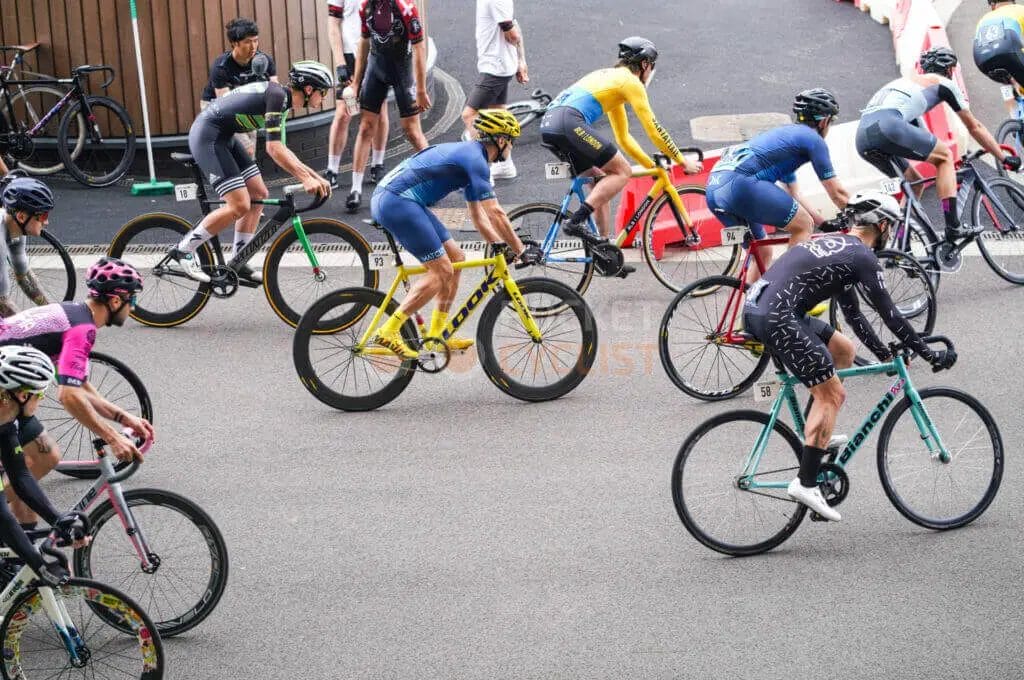Last Updated on April 7, 2024 by Vinson Lozano

Cycling is not only a great way to stay fit and healthy but also an effective way to burn calories. Many people wonder how long they need to cycle to burn a significant number of calories. Let’s explore the concept of calorie burn through cycling and the factors that can affect it.
The concept of burning calories through cycling
When you cycle, your body utilizes energy to power your muscles and maintain your speed and endurance. This energy expenditure is measured in calories. The number of calories burned depends on various factors, such as your weight, cycling intensity, and duration.
Cycling at a moderate pace can help you burn approximately 300-600 calories per hour. However, if you increase your intensity or incorporate interval training, you can increase your calorie burn even more.
Generally, the more effort you put into your cycling session, the more calories you will burn.
Factors affecting calorie burn during cycling

Several factors can influence the number of calories burned during a cycling workout:
- Body weight: Heavier individuals tend to burn more calories as it takes more energy to propel their bodies forward.
- Cycling speed: Higher speeds require more effort, leading to increased calorie burn.
- Resistance: Riding uphill or using resistance on a stationary bike can help burn more calories.
- Duration: The longer you cycle, the more calories you will burn.
In summary, the number of minutes it takes to burn 1,000 calories through cycling depends on several factors including body weight, cycling intensity, and duration. If you want to maximize your calorie burn, consider increasing the intensity and duration of your cycling sessions while enjoying the numerous health benefits that cycling has to offer.
Cycling at a moderate pace
If you’re looking to burn calories and get in shape, cycling can be a great option. But how many minutes of cycling does it take to burn 1,000 calories? Let’s dive into the details.
Calorie burn during cycling at a moderate pace
The number of calories you burn while cycling depends on various factors, such as your weight, intensity, and duration of the exercise. On average, a 155-pound person cycling at a moderate pace (12-14 mph) can burn approximately 260-470 calories in 30 minutes.
To calculate the number of calories burned during your cycling session, you can use an online calorie calculator or fitness tracking devices that provide accurate measurements based on your personal information.
Recommended duration to burn 1,000 calories
To burn 1,000 calories through cycling alone, you would need to increase the duration of your workout. For example:
- A person weighing 155 pounds can expect to burn around 520-940 calories per hour during moderate-paced cycling.
- Therefore, it would take approximately 2 hours and 15 minutes to 4 hours of continuous cycling at a moderate pace for that person to burn 1,000 calories.
Remember, these numbers are approximate and can vary depending on individual factors. It’s always best to consult with a healthcare professional or fitness expert to determine the most suitable exercise routine for your specific goals and needs.
In conclusion, cycling at a moderate pace can be an effective way to burn calories and achieve your fitness goals. Just ensure you maintain proper form, stay hydrated, and listen to your body’s cues for a safe and enjoyable workout experience.
Cycling at a vigorous pace

If you’re looking to shed some calories and get fit, cycling at a vigorous pace can be a great option. Not only does it provide an excellent cardiovascular workout, but it also helps in burning calories. So, how many minutes of cycling does it take to burn 1,000 calories?
Calorie burn during cycling at a vigorous pace
The number of calories burned during cycling depends on various factors such as your weight, speed, and intensity of the workout. On average, cycling at a vigorous pace can burn approximately 500-600 calories per hour.
Estimated time required to burn 1,000 calories
Based on the average calorie burn, it would take approximately 1.5-2 hours of cycling at a vigorous pace to burn 1,000 calories. However, it’s important to note that this is just an estimate and individual results may vary.
To maximize calorie burn during your cycling session, you can incorporate interval training or hill climbs to increase the intensity. Additionally, factors such as wind resistance and terrain can also impact the number of calories burned.
It’s worth mentioning that calorie burn is just one aspect of an effective fitness routine. It’s important to combine cycling with a balanced diet and other forms of exercise for overall health and fitness.
In conclusion, cycling at a vigorous pace can be an effective way to burn calories. By incorporating this activity into your routine and maintaining consistency, you can achieve your fitness goals while enjoying the benefits of this low-impact exercise.
Uphill cycling

Cycling is a popular form of exercise that not only helps improve cardiovascular fitness but also aids in burning calories. If you’re wondering how many minutes of cycling it takes to burn 1,000 calories, it depends on several factors, including the intensity and duration of your ride.
Calorie burn during uphill cycling
When you cycle uphill, you engage more muscles and work harder, resulting in a higher calorie burn. On average, cycling uphill can help burn anywhere between 500-1000 calories per hour, depending on factors such as your weight, speed, and intensity of the climb.
Duration and intensity to achieve 1,000 calorie burn
To burn 1,000 calories through uphill cycling, the duration and intensity of your ride play a crucial role. For example, if you weigh around 155 pounds and cycle at a moderate intensity of 12-14 mph, it would take approximately 75-90 minutes of continuous uphill cycling to reach the 1,000 calorie mark.
However, if you increase the intensity by choosing steeper inclines or riding at a faster pace, you can achieve the same calorie burn in a shorter amount of time.
It’s important to note that these numbers are estimates and may vary based on individual factors such as weight, muscle mass, and overall fitness level. To get the most accurate estimate for your specific circumstances, consider using a heart rate monitor or fitness tracker that can provide real-time calorie burn data during your cycling sessions.
In conclusion, uphill cycling is an effective way to burn calories and improve your fitness. By adjusting the duration and intensity of your ride, you can customize your workout to reach a calorie burn goal of 1,000 calories.
Interval training on a stationary bike
If you are looking to burn a significant amount of calories, interval training on a stationary bike can be an effective option. This type of training involves alternating between periods of high-intensity exercise and low-intensity recovery. It not only helps to burn calories but also improves cardiovascular fitness and builds endurance.
Calorie burn during interval training sessions

The number of minutes required to burn 1,000 calories during cycling can vary depending on factors such as your weight, intensity level, and fitness level. On average, a person weighing around 155 pounds can expect to burn approximately 260-680 calories per hour of moderate cycling, and 590-930 calories per hour of vigorous cycling.
Therefore, it would take approximately 1.5 to 3.8 hours of moderate cycling or 1.1 to 1.7 hours of vigorous cycling to reach a 1,000-calorie burn.
Effective techniques to reach 1,000 calorie burn
To maximize calorie burn during your cycling sessions, here are some effective techniques:
- Incorporate high-intensity interval training (HIIT) into your routine, alternating between intense bursts of cycling and periods of recovery.
- Increase resistance or incline to challenge your muscles and increase calorie burn.
- Extend the duration of your cycling sessions, gradually increasing the intensity and duration over time.
- Incorporate other forms of exercise, such as strength training or circuit training, to further boost calorie burn.
- Maintain proper form and pedal at a steady pace throughout your workout.
By utilizing these techniques and maintaining consistency, you can achieve the calorie burn necessary to reach your fitness goals. Remember to listen to your body and consult with a healthcare professional before starting any new exercise routine.
Other factors influencing calorie burn

While the number of minutes needed to burn 1,000 calories during cycling depends on several factors, including intensity and weight, the average person can expect to burn around 600-800 calories per hour of moderate cycling.
Weight, age, and fitness level impact on calorie burn
- Weight: Heavier individuals tend to burn more calories than lighter individuals during physical activities like cycling.
- Age: Metabolism typically slows down with age, resulting in fewer calories burned.
- Fitness level: Those who are more physically fit may burn calories at a higher rate due to a stronger cardiovascular system.
Tips to maximize calorie burn during cycling
- Increase intensity: Cycling at a higher intensity, such as incorporating intervals or hill climbs, can help burn more calories in less time.
- Add resistance: Using a higher resistance on your bike or cycling uphill can require more effort and increase calorie burn.
- Extend duration: Increasing the duration of your cycling sessions can naturally lead to burning more calories.
- Incorporate strength training: Building muscle through strength training exercises can increase your basal metabolic rate, leading to higher calorie burn even when not cycling.
- Stay consistent: Consistency is key when it comes to burning calories. Aim for regular cycling sessions to maximize calorie burn over time.
In conclusion, the number of minutes it takes to burn 1,000 calories during cycling varies based on factors such as intensity and weight. However, by incorporating strategies to increase intensity and duration, individuals can maximize their calorie burn and achieve their fitness goals faster.
Conclusion
Cycling is a fantastic way to burn calories and stay fit. By cycling at a moderate to high intensity, you can easily burn 1,000 calories in just under an hour.
It offers numerous health benefits, such as improving cardiovascular fitness, strengthening muscles, and increasing endurance. Additionally, cycling is a low-impact activity that is gentle on the joints, making it suitable for people of all ages and fitness levels.
Summary of calorie burn through cycling
To burn 1,000 calories through cycling, the duration and intensity of your ride play crucial roles. Here’s a breakdown of the approximate time required for different intensities:
- High-intensity cycling (20 mph): around 30 minutes
- Moderate-intensity cycling (15 mph): around 45 minutes
- Low-intensity cycling (10 mph): around 75 minutes
Keep in mind that these figures can vary depending on factors such as your weight, fitness level, and terrain. It’s always advisable to consult with a fitness professional or use a heart rate monitor to accurately track your calorie expenditure.
Personal considerations for achieving calorie burn goals
While burning 1,000 calories through cycling is achievable, it’s important to consider your personal circumstances. Factors such as your current fitness level, any medical conditions, and time constraints should be taken into account.
It’s essential to start slowly and gradually increase the intensity and duration of your rides to avoid injury or exhaustion. Remember to stay hydrated, fuel your body with proper nutrition, and listen to your body’s signals during your cycling sessions.
Incorporating regular cycling into your fitness routine is an excellent way to achieve your calorie burn goals while enjoying the outdoors and improving your overall health. So hop on your bike and start pedaling towards a fitter you!
FAQ (Frequently Asked Questions)
Common queries related to calorie burn and cycling
If you’re looking for an effective way to burn calories and stay fit, cycling is a great option. Here are some common queries related to calorie burn and cycling:
How many minutes of cycling burns 1,000 calories?
The number of minutes it takes to burn 1,000 calories through cycling depends on various factors such as your weight, intensity of the ride, and speed.
On average, a person weighing around 150 pounds can burn approximately 400-500 calories per hour of moderate-intensity cycling. This means it would take around 2-2.5 hours of cycling to burn 1,000 calories.
Can I burn more calories with high-intensity cycling?
Yes, high-intensity cycling can help you burn more calories in a shorter amount of time. By increasing your cycling speed or incorporating intervals of high-intensity sprints, you can elevate your heart rate and increase your calorie burn.
A 30-minute high-intensity cycling session can potentially burn around 400-600 calories.
Does the type of terrain affect calorie burn?
Yes, the type of terrain you ride on can have an impact on your calorie burn. Uphill rides or rough terrains require more effort and engage different muscle groups, resulting in a higher calorie burn compared to flat or smooth terrains.
In summary, the number of minutes it takes to burn 1,000 calories through cycling depends on various factors. However, on average, it would take around 2-2.5 hours of moderate-intensity cycling to achieve this calorie burn.
Incorporating high-intensity sessions or riding on challenging terrains can further increase your calorie expenditure.


